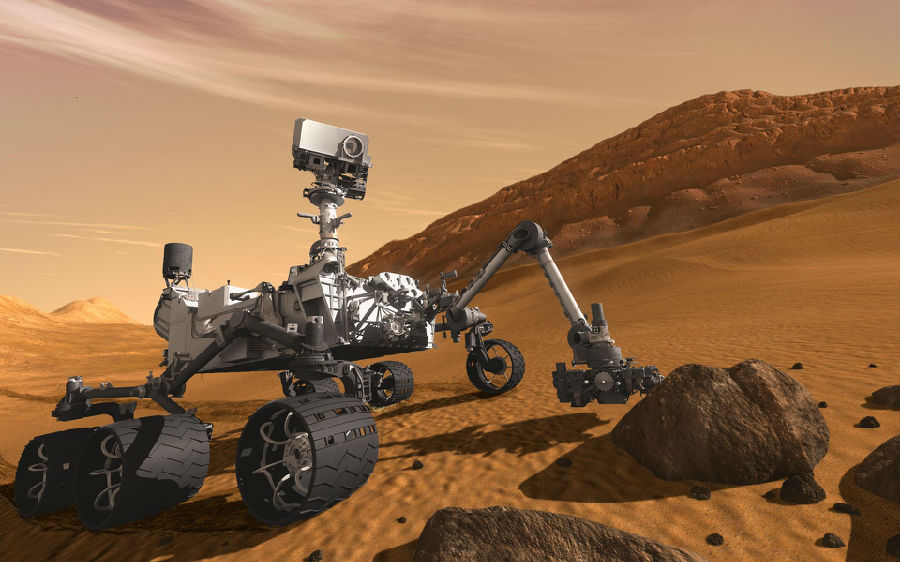For the first 56 sols, Opportunity never strayed more than ten metres from that propitious landing site. It took pictures with its various cameras, ground holes with its little rasping drill, dug a trench by spinning one wheel while it kept the others locked, measured the spectra of various minerals. The scientists concluded that the sediments they saw had been laid down in a salty dying sea. If that had been all Opportunity had ever told them, the mission would have been counted a great success.
前56個火星日,機遇號從未偏離過那個幸運的著陸點十米以上。它用各種各樣的照相機拍照,用小銼刀鉆地洞,一邊轉動一個輪子,一邊將另一個輪子鎖住,挖出一條溝渠,測量各種礦物的光譜。科學家們得出結論,他們所看到的沉積物是沉積在含鹽量很高的瀕死海域。如果這一切都是通過機遇號得知的,那么這次任務就算得上是一次巨大的成功。
But on Sol 57, it ventured out into the wider world.
但是到了第57個太陽日,機遇號冒險進入更廣闊的世界。

Guided by pictures from satellites above, Opportunity headed for a deeper crater, Endurance, a kilometre or so away. It drove down into it and looked around further, poking and prodding for the rest of the year. A human geologist might have accomplished as much or more by way of assessment in a leisurely afternoon. But the nearest human geologists were on another planet, and likely to remain there for some decades to come.
在衛星回傳圖像的指引下,“機遇號”向一公里外的一個更深的隕石坑進發。它開進洞里,四處張望,在這一年剩下的時間里不斷挖刨。一個人類地質學家在一個悠閑的下午可能已經完成了或多或少的評估。但這位最接近人類的地質學家曾在另一顆星球上,而且很可能在未來幾十年里繼續留在那里。
After climbing back out of Endurance—no one had known whether it would be able to—Opportunity was sent off to inspect the jettisoned heat-shield that had protected it as it burned down through the Martian atmosphere, now a glinting monument on the pockmarked plain. It was not the only thing that had fallen from the sky. As it rolled on, Opportunity came across a meteorite, its lithology distinctively un-Martian. Later it took a little video of Phobos, the larger of Mars’s small moons, passing as a shadow across the face of the Sun.
在耐力恢復后——無人能知道它是否能做到——“機遇號”被派去檢查被丟棄的隔熱罩,它在火星大氣層中被燒毀時,隔熱罩保護著它,現在它是火星坑洼平原上閃閃發光的紀念碑。而隔熱罩不是唯一從天上掉下來的東西。隨著“機遇號”繼續前進,它遇到了一顆隕石,其巖性與火星截然不同。后來,它拍攝了一小段關于火衛一的視頻,火衛一是火星上較小的衛星中較大的一個,它以陰影的形式掠過太陽表面。
On Sol 946, in September 2006, Opportunity reached Victoria Crater, seven kilometres from its landing site, 800 metres across. Its makers knew that the 90-sol lifetime they had promised for Opportunity and Spirit was conservative, a low bar to ensure some kudos for “mission accomplished”. But none had expected it to be surpassed by a factor of ten.
在第946個火星日,即2006年9月,機遇號到達維多利亞隕石坑,距離著陸點7公里,直徑800米。其制造商明白所承諾的“機遇號”和“勇氣號”90個太陽日的使用壽命較為保守,目的是先設一個低門檻以確保“任務完成”的榮譽。但沒有人預料到它的使用期限竟然超預期十倍。
譯文由可可原創,僅供學習交流使用,未經許可請勿轉載。












